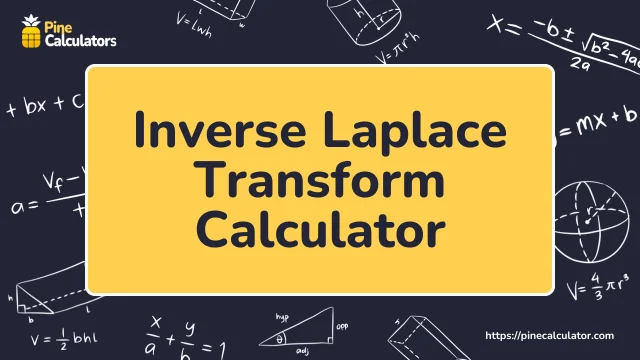Introduction to Inverse Laplace Transform Calculator With Steps:
Inverse laplace transform calculator is an amazing source designed to find the time-domain function f(t) from its Laplace-domain function F(s). It simplifies the process of solving differential equations and analyzing the linear systems from the complex function transformations.

It is a beneficial tool for all as it is used in various fields like engineering, physics, and applied mathematics to solve differential equations and systems analysis problems.
What is the Inverse Laplace Transform?
Inverse Laplace transform is a process that transforms the function, present in the complex frequency domain, into the function present in the time domain. If F(s) is the Laplace transform of a time-domain function f(t), then the inverse Laplace transform of F(s) is f(t).
Mathematically, if F(s) is the Laplace transform of f(t) i.e.
$$ f(t) \;=\; L^{−1}F(s) $$
How to Calculate Inverse Laplace Transform?
For the calculation of the inverse Laplace transform you need to know its properties so that you can easily solve these functions, especially when done manually. Here’s a step-by-step of solving the inverse laplace transform function.
Step 1: Identify the given Laplace Transform F(s).
Step 2: After identifying, check which method is used that gives an appropriate solution of the given inverse laplace transform function with or without the integration process.
Step 3: For more complex forms like rational functions, use partial fraction decomposition to break down F(s) into simpler fractions. Then you can easily use the laplace transform rule for direct solution.
Step 4: After using partial fraction decomposition, when you know the type of Laplace transform function, apply the inverse Laplace transform formula directly.
Step 5: You can check your solution by differentiating f(t) and applying the original laplace transform to see if it matches F(s) and simplify it.
Step 6: If the problem includes initial conditions ( f(0), f′(0), etc.), apply these values in the final solution using the properties of Laplace transforms.
This process helps you to calculate inverse Laplace transforms and solve problems involving differential equations and system analysis. If you prefer not to calculate it manually, you can use our inverse laplace transform calculator as It gives you a detailed solution in just a few seconds.
Practical Example of Inverse Laplace Transform:
The example of inverse laplace transform function with solution gives you conceptual clarity about this method. So, let’s dive in,
Example: Find the inverse laplace of:
$$ F(s) \;=\; \frac{1}{s(s+1)} $$
Solution:
The integral function that we want to evaluate for conversion,
$$ f(t) \;=\; \frac{1}{2 \pi i} \int_{c-i \infty}^{c+i \infty} \frac{e^{st}}{s(s+1)} ds $$
In this given example F(s) pole is s=0 and s=-1 and its residue at z=0 and z=-1 is
At z=0,
$$ Res \left[ \frac{e^{zt}}{z(z+1)};\; z \;=\; 0 \right] \;=\; \lim_{z \to 0} \frac{e^{zt}}{(z+1)} \;=\; 1 $$
At z=-1,
$$ Res \left[ \frac{e^{zt}}{z(z+1)};\; z \;=\; -1 \right] \;=\; \lim_{z \to -1} \frac{e^{zt}}{z} \;=\; -e^{-t} $$
According to the above formula, put the values in it the solution becomes,
$$ f(t) \;=\; 2 \pi i \left[ \frac{1}{2 \pi i}(1) + \frac{1}{2 \pi i}(-e^{-t}) \right] \;=\; 1 - e^{-t} $$
Therefore the solution of the given function is 1-e-t.
How to Use the Laplace Inverse Transform Calculator?
Laplace transform inverse calculator has an easy-to-use interface, so you can easily use it to evaluate the inverse laplace transform questions. Follow these simple steps before adding inputs to the solutions so that you don't get irritated. These steps are:
- Enter the inverse laplace transform function F(s) in the input box.
- Review your inverse laplace function input before hitting the calculate button.
- Click on the “Calculate” button to get the desired result of your given inverse laplace transform problem.
- If you want to try our laplace transform inverse calculator's accuracy in the solution you can use the load example option.
- Click on the “Recalculate” button to get a new page for solving more inverse laplace transform questions
Final Result of Inverse Transform Laplace Calculator:
Inverse laplace transform calculator gives you the solution to a given problem when you give it the input. It provides you with solutions which may contain as:
- Result Option:
You can click on the result option and it provides you with a solution of inverse laplace transform questions.
- Possible Step:
When you click on the possible steps option it provides you with the step by step solution of the inverse laplace transform problem.
- Plot Option:
It gives you a solution in the form of a graph so that you get a visual understanding as well.
Advantages of Laplace Inverse Transform Calculator:
Laplace transform inverse calculator gives you tons of advantages whenever you use it to calculate inverse laplace transform function problems. These advantages are:
- Our inverse transform laplace calculator saves the time and effort that you consume in solving complex inverse laplace function questions.
- It is a free-of-cost tool that gives you a solution of inverse laplace transform function to convert it into a laplace transform function again for free.
- Inverse laplace transform calculator with steps is an adaptive tool that allows you to get accurate results from the given inverse laplace transform function problem quickly and easily.
- You can use this calculator for practice to get a strong hold on how to convert function into laplace transformation.
- laplace inverse transform calculator is a trustworthy tool that provides you with accurate solutions as per your input to calculate the inverse laplace transform function problem.










